
Diagnostic radiology vs. ophthalmology is one of the biggest debates among medical students interested in physiology. Both specialties allow you to explore the complex workings of the human body and use your skills to improve patient outcomes. However, they also have significant differences, such as the scope of practice, the work environment, and the training requirements.
How do you decide which one is right for you? In this article, we will provide helpful information and tips to help you make an intelligent decision on diagnostic radiology vs. ophthalmology and find a fulfilling career that matches your interests and abilities. We will also help you evaluate practical factors such as job availability, salary, and training duration.
Diagnostic Radiology vs. Ophthalmology: Salary and Job Security
Consider specializing in diagnostic radiology or ophthalmology if you want to earn a lot of money and have a steady demand for your services. There are many job openings in the fields of diagnostic radiology and ophthalmology. Hospitals are often in high demand for radiologists and ophthalmologists, and the future outlook for careers in these specialties is positive.
Both are high-paying medical specialties, but radiologists typically earn a higher average salary. According to recent data, radiologists earn an average annual salary of $483,000, while ophthalmologists have a lower average salary of $388,000.
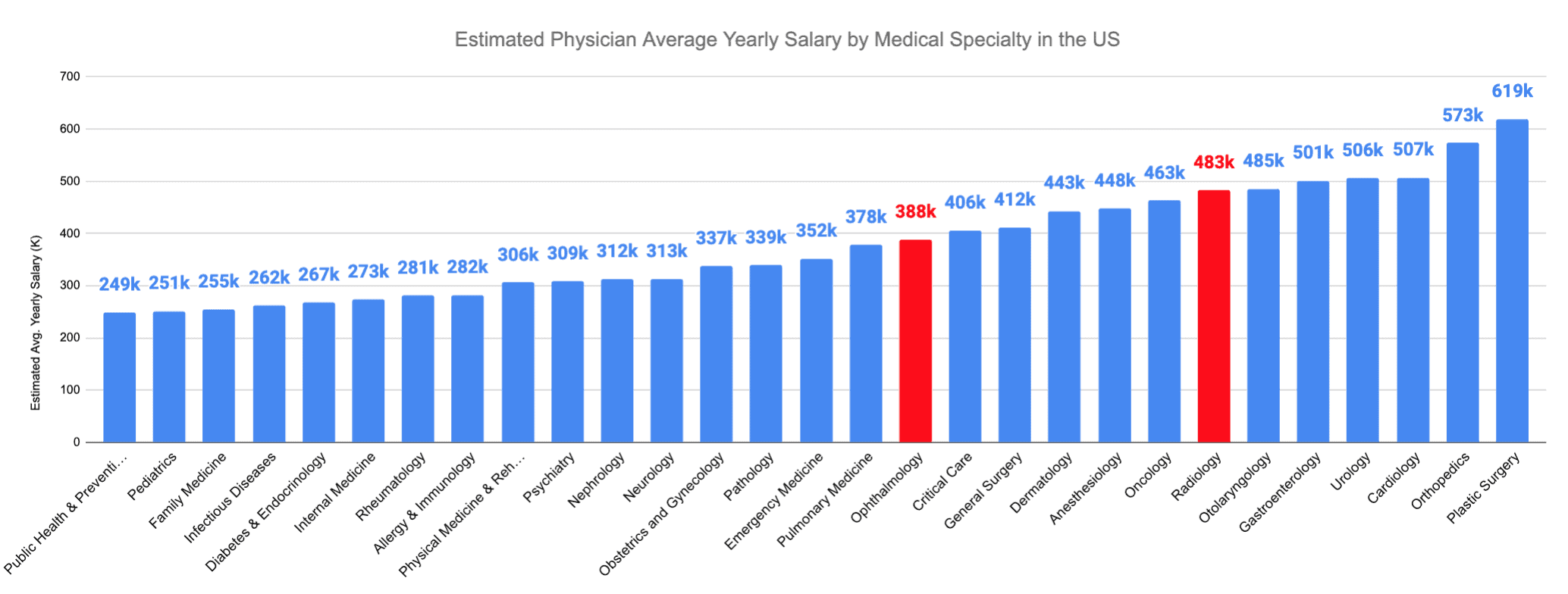
Radiologists earn $483,000 per year on average, while ophthalmologists earn less with $388,000 annually
Diagnostic Radiology vs. Ophthalmology: Competitiveness
Here we can assess the competitiveness of a specialty by looking at the unmatched rate – the % of people who apply and do not match into their preferred specialty. The unmatched percentage among US Seniors for diagnostic radiology was 16.8%, making it moderately competitive among US residencies.
To become an ophthalmologist, graduates must complete a one-year internship in internal medicine, followed by a three-year residency program in ophthalmology. The percentage of US seniors who were unmatched in internal medicine was 2.0%, making it a less competitive residency in the 2022 match.
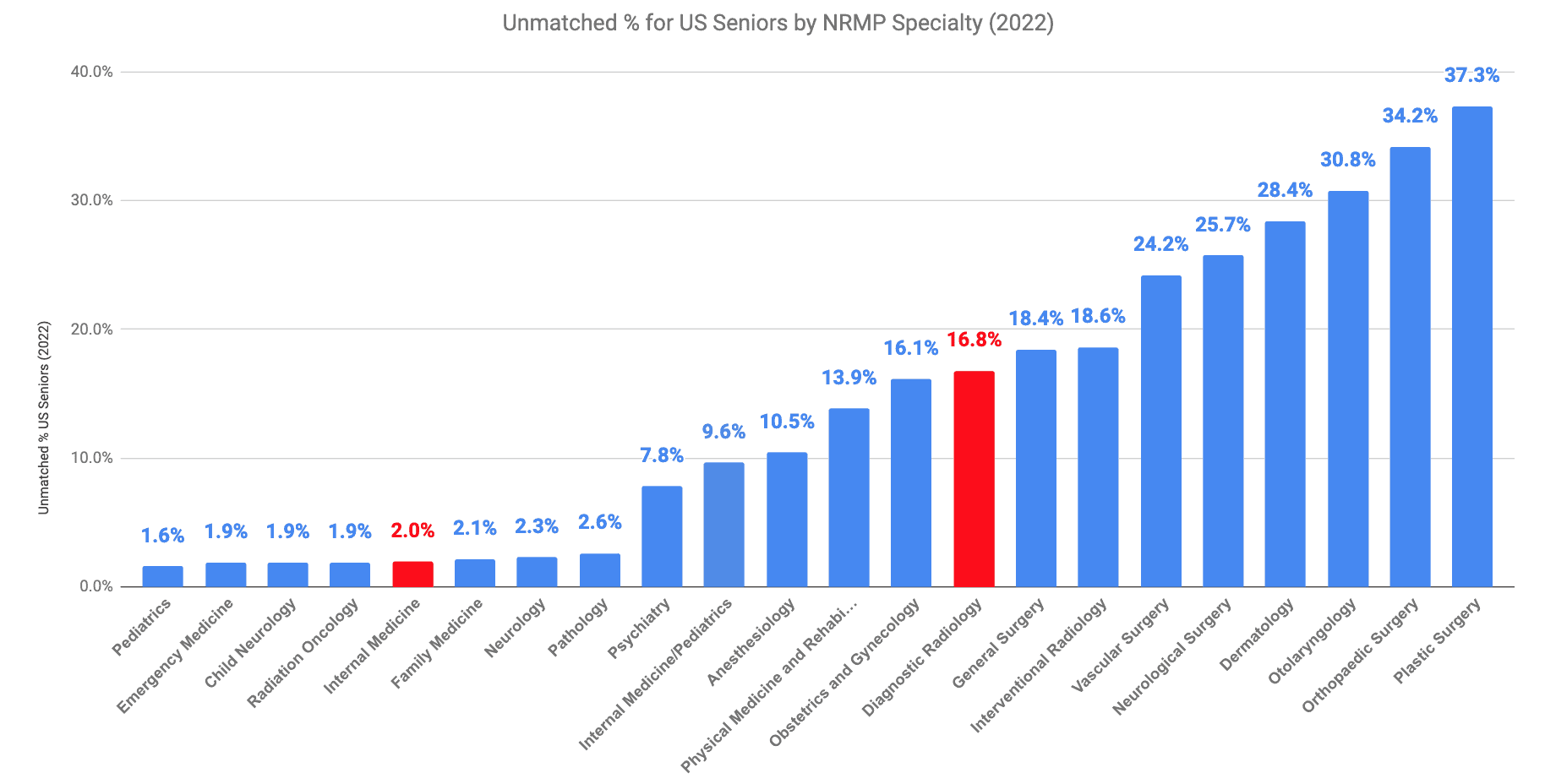
Diagnostic radiology had a 16.8% unmatched rate, while internal medicine had a 2% unmatched rate among US seniors
Training Path: Residency
The training pathways for diagnostic radiology vs. ophthalmology are not the same. Ophthalmology involves a four-year ophthalmology residency. Diagnostic radiology involves a five-year radiology residency.
Ophthalmology residencies are typically less competitive than diagnostic radiology residencies. Your USMLE scores, med school, and research are the main things for residency applications. Research is also a big thing for fellowship applications, and your residency program counts more, but your USMLE scores matter much less.
Diagnostic Radiology vs. Ophthalmology: Work-Life Balance
Work-life balance is a crucial factor for many medical professionals. Both diagnostic radiology and ophthalmology offer a better work-life balance than surgical specialties. Radiologists often enjoy the flexibility of remote work opportunities, resulting in a favorable work-life balance. Similarly, ophthalmologists typically have set working hours and predictable schedules, whether in outpatient settings or hospital environments.
On average, radiologists work 49.6 hours per week, ranking below the middle of all medical specialties. In comparison, ophthalmologists average 45.3 weekly working hours, ranking near the lower end.
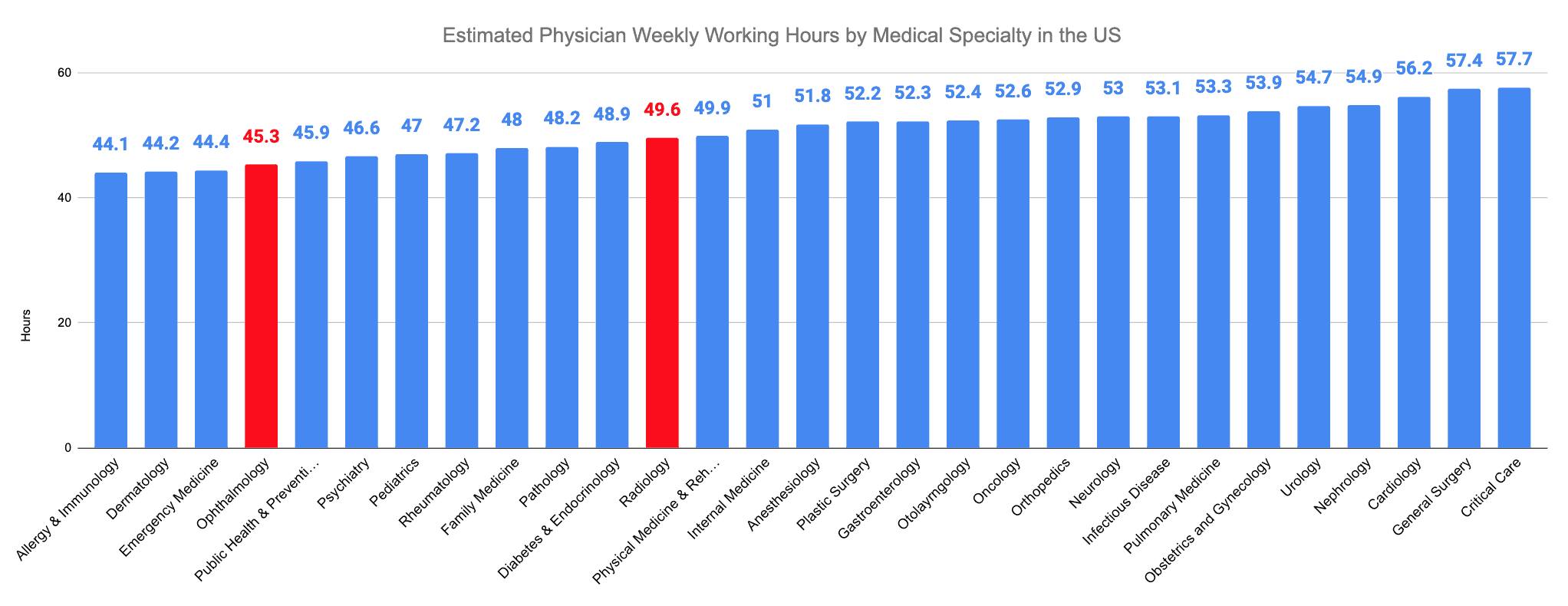
Radiologists work an average of 49.6 hours per week, while ophthalmologists work fewer hours, at 45.3 per week
Both radiologists and ophthalmologists have to deal with hours of documentation. Radiologists spend an estimated 11 hours on admin and paperwork per week, while ophthalmologists spend slightly less with 10 hours per week.
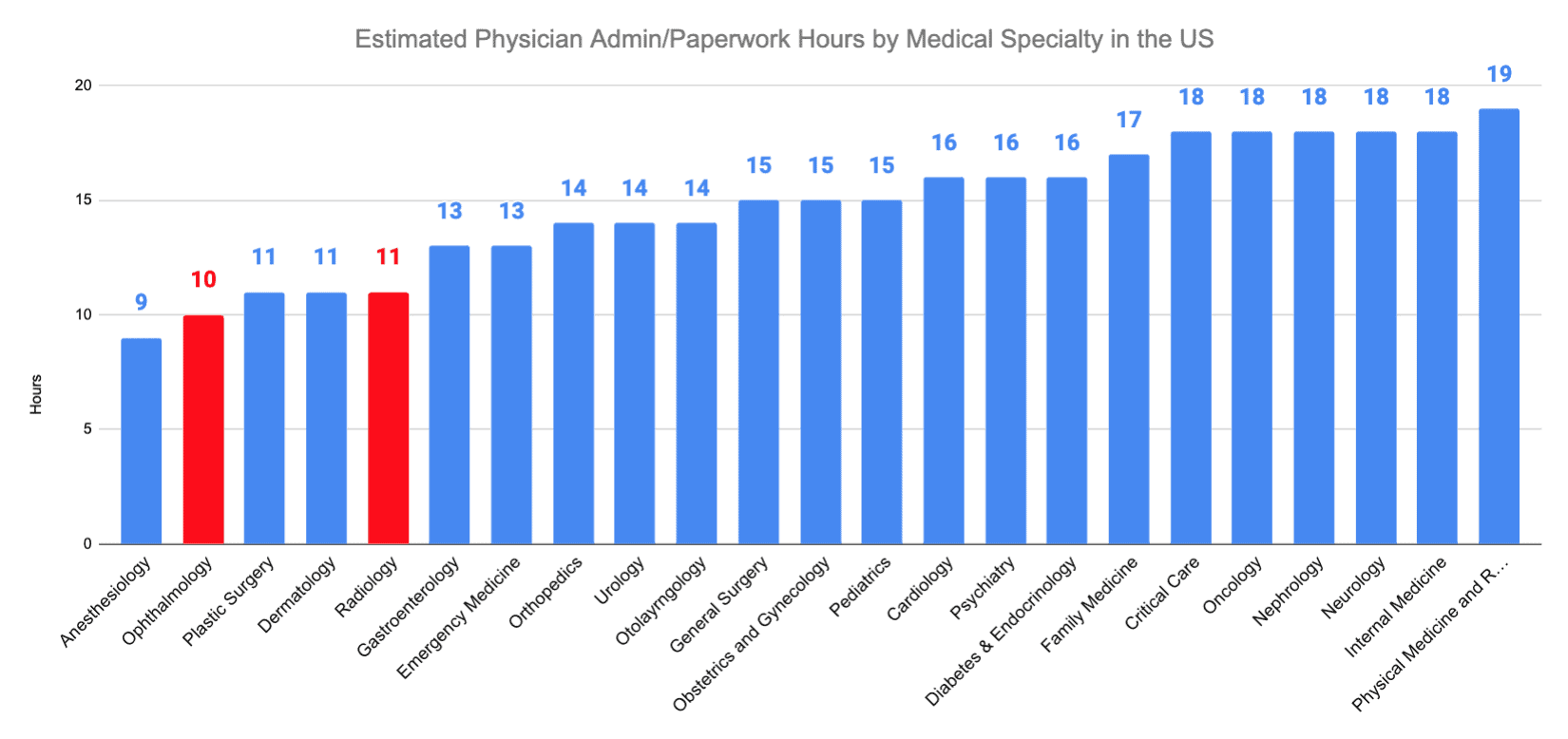
Radiologists work on admin/paperwork an average of 11 hours per week, while ophthalmologists work slightly fewer hours, at 10 per week
Training Duration and Subspecialties
The training duration is a key aspect to consider when choosing between diagnostic radiology vs. ophthalmology. Ophthalmology has a four-year training period, while diagnostic radiology has a minimum of five years of diagnostic radiology residency.
After completing a diagnostic radiology residency program, some radiologists may pursue additional fellowships to further specialize in a particular aspect of diagnostic radiology, such as interventional radiology or musculoskeletal imaging. This can increase the length of their diagnostic radiology training.
Diagnostic Radiology vs. Ophthalmology: Job Satisfaction and Burnout Rates
Job satisfaction plays a significant role in career fulfillment. According to various studies, both radiologists and ophthalmologists tend to have high job satisfaction rates, with many professionals expressing contentment with their career choice and would choose it again if given the chance.
According to recent data, ophthalmology ranked near the upper end of all medical specialties with 92% of ophthalmologists stating that they would choose the same specialty again, while diagnostic radiology ranked slightly lower with 90% of radiologists feeling the same way.
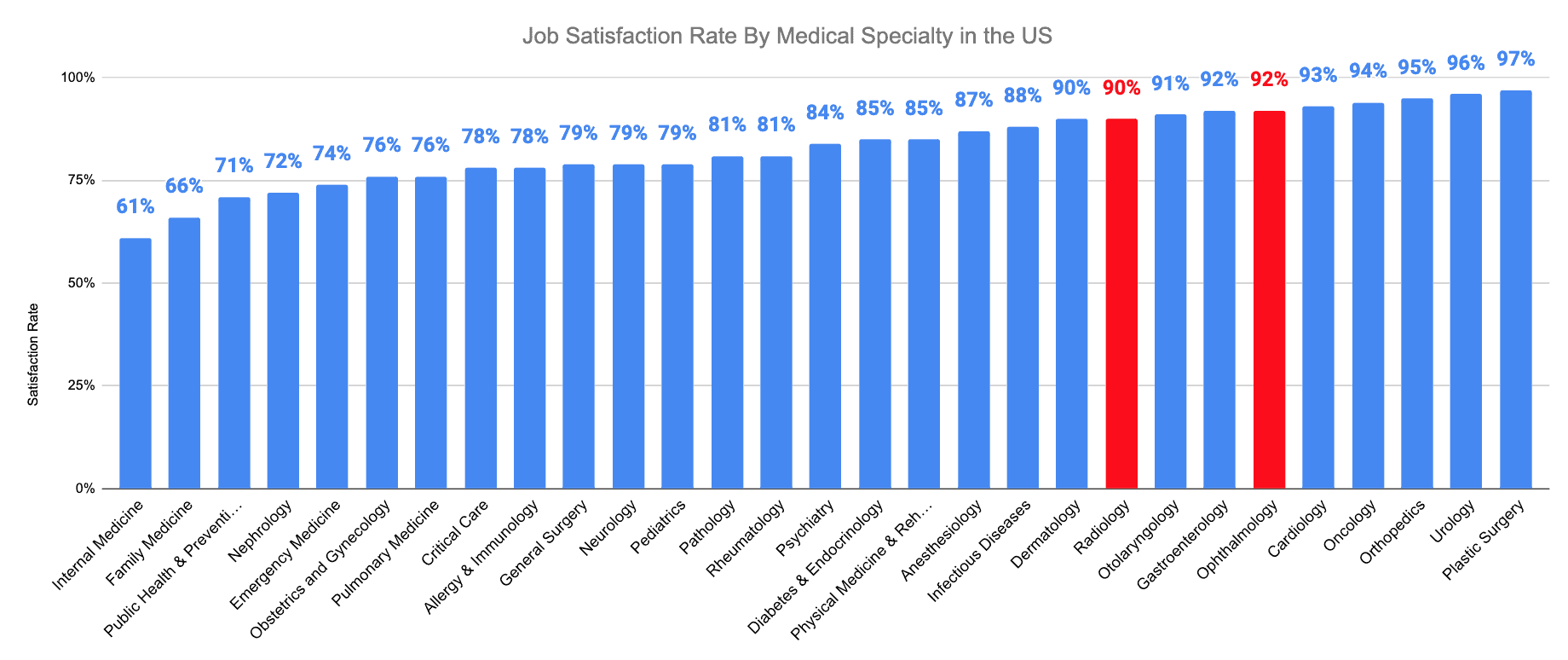
Radiologists reported a 90% job satisfaction rate, while ophthalmologists reported higher satisfaction with 92%
That being said, the burnout rate for radiology was 54%, ranking above the middle of all medical specialties. In comparison, ophthalmology had a burnout rate of 48%, ranking below the middle.
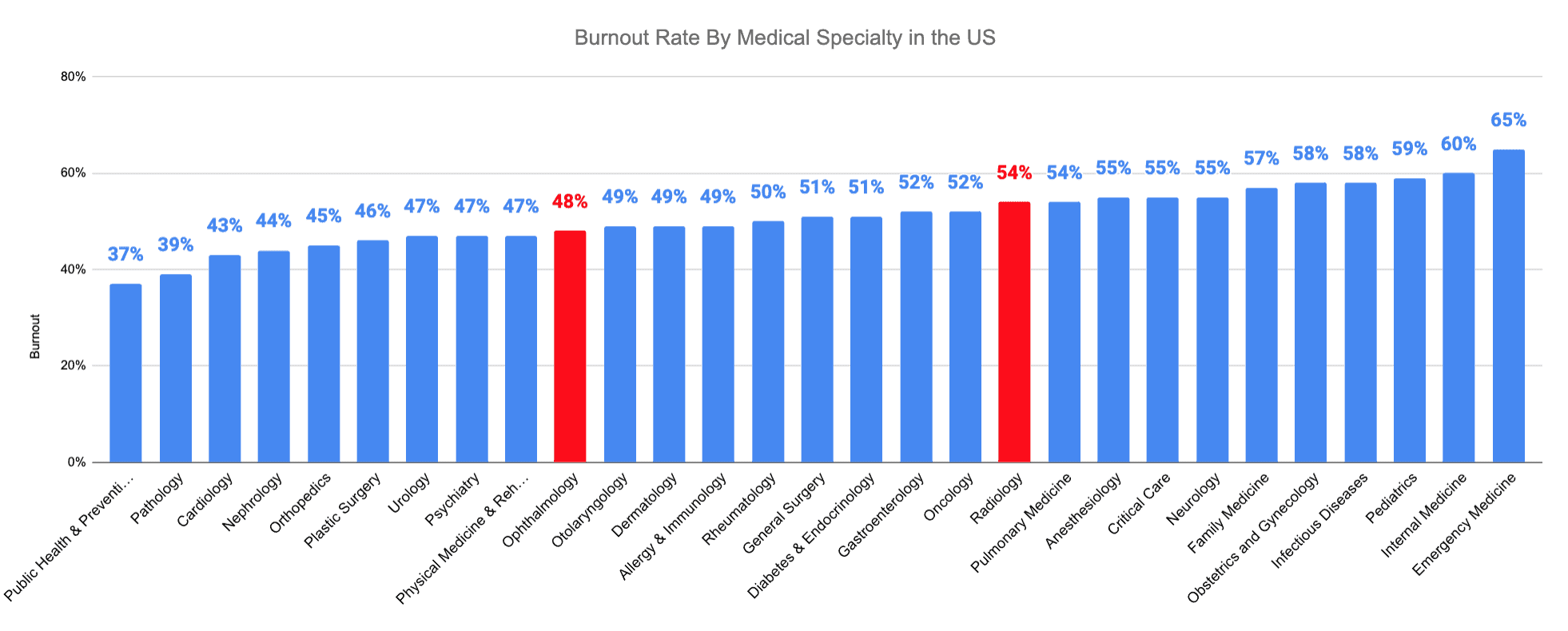
Radiologists have a burnout rate of 54%, while ophthalmologists have a burnout rate of 48%.
Diagnostic Radiology vs. Ophthalmology Comparison
To provide a visual overview, here’s a table comparing diagnostic radiology and Ophthalmology:
| Aspect | Diagnostic Radiology | Ophthalmology |
|---|---|---|
| Average Salary | Generally high income | Competitive salary, with potential for high earnings in subspecialties like retinal surgery |
| Job Security | High demand due to importance of imaging in diagnosis and nonsurgical treatments | Stable demand, as vision issues are prevalent across age groups |
| Training Path | Typically involves 5 years of radiology residency | Typically involves 4 years, including one preliminary internal medicine and 3 years of ophthalmology residency |
| Lifestyle | Better work-life balance, no take-home work | Generally predictable working hours |
| Administrative Paperwork | Low documentation requirements | Lower documentation requirements |
| Job Satisfaction | High | High |
| Burnout Rates | Moderate | Lower |
| Personality | Analytical, technology-oriented, ability to multitask | Precision and attention to details |
Please note that this table serves as a general comparison. To determine the most suitable career for you, consider your personal and career priorities and goals.
Concluding Thoughts
Choosing the right specialty between diagnostic radiology vs. ophthalmology depends heavily on your priorities. To determine this, try reverse engineering your ideal life and identify your top priority. A helpful exercise is to write down the top five things you want to achieve in your career and personal life. Knowing these priorities will make finding a job that aligns with them easier. Often, the biggest obstacle is not a lack of knowledge about different fields but a lack of self-awareness about our preferences.







